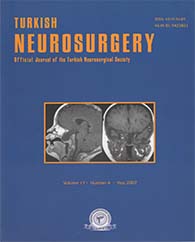MATERIAL and METHODS: Peripheral nerves in the upper extremity were evaluated by using real-time ultrasonographic examination. The capability of ultrasonography in terms of determination the type of injury, the position of the proximal and distal nerve stumps, the presence or absence of a neuroma and perilesional scar tissue were evaluated in cases with peripheral nerve injury.
RESULTS: Thirty-six cases with upper extremity peripheral nerve injury aged between 24 and 60 years were included in this study. Four (11%) had brachial plexus injury, 9 (26%) ulnar nerve injury, 6 (16%) radial nerve injury and the remaining 17 (47%) cases had median nerve injury. The capability of ultrasonographic examination was satisfactory for all evaluation parameters.
CONCLUSION: Preoperative and intraoperative ultrasonography for upper extremity peripheral nerve lesions may be used in the description of the degree of injury, determination of complete or incomplete nerve sectioning, the presence of hematoma and foreign body, the continuity of the nerve, determination of nerve stumps and perilesional scar tissue, and the presence of neuroma.
Keywords : Peripheral nerve injury, Ultrasonography, Surgical treatment




